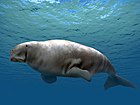Lentiarenium
| Lentiarenium | |
|---|---|

| |
| Lectotype mandible of Lentiarenium | |
| Scientific classification | |
| Domain: | Eukaryota |
| Kingdom: | Animalia |
| Phylum: | Chordata |
| Class: | Mammalia |
| Order: | Sirenia |
| Family: | Dugongidae |
| Genus: | †Lentiarenium Voss et al., 2016 |
| Species | |
| |
Lentiarenium was an early
History and naming
The earliest discoveries of Lentiarenium date to the early 19th century, with a mandible, ribs, vertebrae and molars being found in sandpits of the city of

However, the assignment of the material to Halitherium became increasingly problematic due to the nature of the genus and its long and complex history. Over time Halitherium had become a wastebasket taxon for many otherwise unrelated sirenians that thrived in the sea that covered Europe throughout the Neogene. Additionally, the stability of Halitherium itself is questionable, as its type species, H. schinzii, was based on a single isolated tooth found to have no diagnostic value, thus rendering the genus a nomen dubium.[7] This led to a rash of reexaminations of Halitherium remains in the subsequent years, resulting in many specimens being given their own genera. Besides Lentiarenium, this included Kaupitherium (Halitherium bronni) and Italosiren (Halitherium bellunense).[8]
As part of this spike in research; Voss, Berning and Reiter published their examination of the upper Austrian seacow material in 2016, with the express goal to test Domning's synonymisation of H. christolli, H. abeli and H. pergense. The team concludes that the synonymy is justified and that there is no evidence for the three previously named taxa representing morphospecies. Given the dubious nature of Halitherium, the genus Lentiarenium was coined with L. cristolii continuing to serve as the type species. As the type species was described on a series of
Etymology
The name Lentiarenium is composed of "Lentis", the Latin name for the city of Linz, and "arenium" meaning sand, ultimately a direct translation of Linz Sands, the informal name of the sediments the material was found in. When describing the type species, Fitzinger believed that Halitherium (named by Kaup in 1838) and Metaxytherium (named by de Christol in 1840) were synonymous. While assigning the species to the older name, he chose to honor Jules de Christol by naming the species after him. However, despite being named after de Christol, Fitzinger spells the genus name "cristolii". Regardless of intent, Voss and colleagues propose that this spelling takes priority over subsequent spellings such as “christoli” and “christolii”, arguing that Fitzinger's continued use of the species name in later publications rules out printing errors or a one-time mistake.[9]
Description

Lentiarenium is known from both cranial and postcranial remains that amount to most of the skeleton except for the
Phylogeny
Phylogenetic analysis have repeatedly shown that Lentiarenium was a derived sirenian compared to other Oligocene and Eocene taxa, but basal to the clade that contains
| |||||||||||||||||||||||||||||||||||||||||||||||||
An alternate hypothesis places Lentiarenium as a dugongid basal to both Caribosiren and Priscosiren. Although Voss and colleagues deem this less likely given the fossil record (as both taxa are from the West Atlantic), it still shows that the genus is neither close to Metaxytherium nor does it nest with other species and genera previously lumped together in Halitherium. A tree such as this has been recovered by Kerber and Moraes–Santos (2021).[11]
| Sirenia |
| ||||||||||||||||||||||||||||||
See also
References
- ^ L. J. Fitzinger. 1842. Bericht über die in den Sandlagern von Linz aufgefunden fossilen Reste eines urweltlichen Säugers, (Halitherium Cristolii). Bericht über das Museum Francisco-Carolinum. Linz 6:61-72
- ^ H. v. Meyer: Mittheilungen an Professor Bronn gerichtet. In: Neues Jahrbuch für Mineralogie, Geognosie, Geologie und Petrefaktenkunde, Jahrgang 1847, 1847, S. 181–196 (Digitalisat).
- ^ H. v. Meyer: Mittheilungen an Professor Bronn gerichtet. In: Neues Jahrbuch für Mineralogie, Geognosie, Geologie und Petrefaktenkunde, Jahrgang 1843, 1843, S. 698–704 (Digitalisat).
- ^ F. Toula: Zwei Säugetierreste aus dem kristallisierten Sandstein von Wallsee in Niederösterreich und Perg in Oberösterreich. In: Neues Jahrbuch für Mineralogie, Geologie und Palaeontologie, Beilagenband 12, Nummer 2, 1899, S. 447–482.
- ^ F. Spillmann: Die Sirenen aus dem Oligozän des Linzer Beckens (Oberösterreich) mit Ausführungen über „Osteosklerose“ und „Pachyostose“. In: Denkschriften der Österreichischen Akademie der Wissenschaften - Mathematisch-Naturwissenschaftliche Klasse, Band 110, 3. Abhandlung, 1959, 65 S.
- ^ D. P. Domning: A Phylogenetic Analysis of the Sirenia. In: A. Berta & T. A. Deméré (Hrsg.): Contributions in Marine Mammal Paleontology Honoring Frank C. Withmore, Jr. – Proceedings of the San Diego Society of Natural History, Band 29, 1994, S. 177–189 (Digitalisat).
- ^ M. Voss. 2014. On the invalidity of Halitherium schinzii Kaup, 1838 (Mammalia, Sirenia), with comments on systematic consequences. Zoosystematics and Evolution 90(1):87-93.
- ^ M. Voss & O. Hampe: Evidence for two sympatric sirenian species (Mammalia, Tethytheria) in the early Oligocene of Central Europe. In: Journal of Paleontology, Band 91, Nummer 2, 2017, S. 337–367 (Digitalisat).
- ^ a b c d M. Voss, B. Berning, and E. Reiter. 2016. A taxonomic and morphological re-evaluation of “Halitherium” cristolii Fitzinger, 1842 (Mammalia, Sirenia) from the late Oligocene of Austria, with the description of a new genus. European Journal of Taxonomy 256:1-32
- S2CID 86498351.
- S2CID 236226810.

